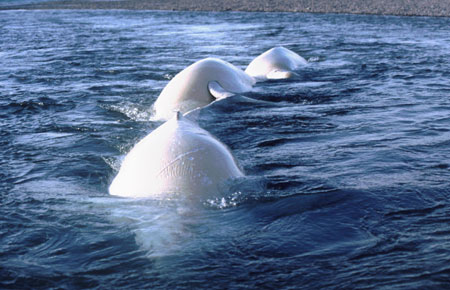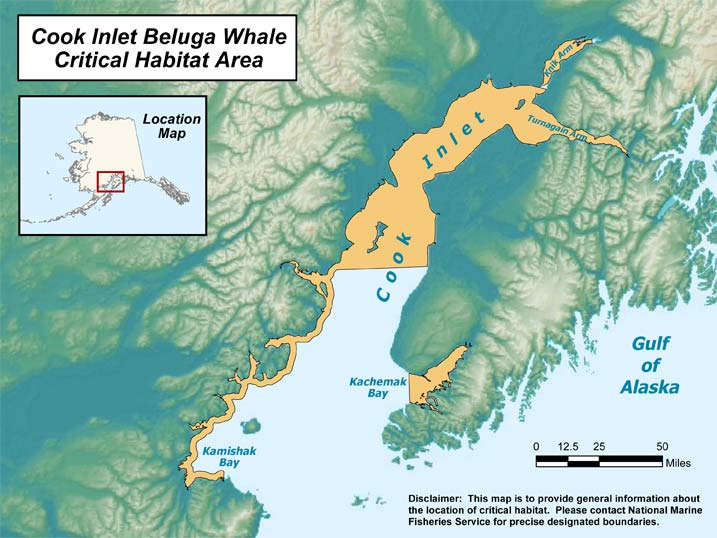
More Studies Will Not Save the Beluga Whale
For Alaskans, one joy that never gets old is seeing Cook Inlet beluga whales as they swim up or down Turnagain Arm. Unfortunately, such spectacles occur with far less frequency today than in years past.
Cook Inlet may have supported a population of 2,000 whales or more at one time, and the National Marine Fisheries Service (NMFS) estimates that approximately 1,300 animals inhabited the inlet in the mid-1980s.
The population saw dramatic declines in the 1990s, falling to 25% to 35% of its pre-1980s population. Over the last 15 years, the population has risen and fallen but always hovered between 300 to 400 whales. Not only has the population failed to rebound, it actually continues to decline. With such a small population, the Cook Inlet beluga whale has been and remains on the verge of extinction.
For decades, Trustees for Alaska has worked to protect this imperiled species. In 1999, Trustees petitioned NMFS to list the species as endangered under the Endangered Species Act (ESA). NMFS refused to list the species on the grounds that measures to address subsistence harvest would lead to recovery. Concerned that the species wouldn’t get the protections it needed to recover under the ESA, Trustees, on behalf of several organizations, challenged the agency decision in 2001. The court, deferring to the agency, found that the decision not to list the species was supported by NMFS’s factual findings. However, the court noted that ESA listing would be warranted in the future if controlling subsistence harvest did not have a positive impact on the population. Trustees’ clients in this case were: Alaska Center for the Environment, Alaska Wildlife Alliance, Alaska Community Action on Toxics, Center for Biological Diversity, National Audubon Society, Sierra Club, and Center for Marine Conservation.
In 2006, Trustees again petitioned NMFS to list the species as endangered. In 2008, NMFS responded to the petition and found that the population was not recovering, despite the cessation of subsistence harvest. NMFS finally decided that the belugas should be listed as endangered. This time, the State of Alaska, afraid that the listing would prevent and preclude economic activity, brought a lawsuit to undo the listing. On behalf of several clients, Trustees intervened. In 2011, the court agreed that the listing should stand, rejecting the State’s arguments and dismissing the lawsuit. Although the beluga remains listed, the whales continue to struggle. Trustees’ clients for this case were: Alaska Center for the Environment, Center for Biological Diversity, Cook Inletkeeper, Natural Resources Defense Council, and North Gulf Oceanic Society.
A range of threats have been identified in the belugas’ struggle to recover:
- Modification and degradation of habitat from oil and gas activities;
- Noise impacts from oil and gas seismic exploration, which consist of sonic booms from airguns that can result in strandings, mortality and displacement;
- Noise impacts from pile driving at the Port of Anchorage and further loss of hunting grounds from Port expansion;
- Dredging activities in critical beluga habitat like at the Ports of Anchorage and Point Mackenzie dredge;
- Exposure to pollutants and contaminants, including the discharge of Anchorage’s wastewater, which to this day only gets primary treatment;
- Declining fish populations due to human activities from fishing and loss of habitat; and,
- Threats of ship strikes from vessel traffic.
Although there are a large number of threats, NMFS has failed to take the requisite steps to minimize and mitigate these threats. As a result, the beluga remains imperiled and shows no signs of recovery.
This summer, NMFS unveiled a draft of the recovery plan for the beluga whale. The recovery plan is supposed to be a roadmap to get the species back to a population level that warrants removing the species from the list of endangered and threatened species. Unfortunately, NMFS has failed to fully assess the threats and identify measures to minimize and mitigate impacts. Instead, NMFS calls for more studies to better understand the threats. While further study is always helpful, a recovery plan that does nothing but attempt to confirm that the threats are indeed real, will at best, delay recovery. At worst, it will lead the beluga whale further down the road towards extinction.
The science available is clear that the threats to the belugas are cumulative, making it hard to pin the decline on any one particular activity. But that does not mean we can’t and should not start taking corrective actions. More is required to protect and conserve the whales. We must take immediate measures to reduce impacts, not just study how damaging those impacts may be. On behalf of Cook Inletkeeper, North Gulf Oceanic Society, and Alaska Community Action on Toxics, Trustees submitted comments on the beluga draft recovery plan.
As we have for the last two decades, Trustees will continue to fight to protect the Cook Inlet beluga whale and ensure that we are taking all the reasonable steps we can to save this incredible species. It is important that one day, our children can experience that incredible feeling of seeing a pod of belugas swim up Turnagain Arm.
If you love belugas as much as we do, consider supporting our work today!
Donate
Read about Trustees work to protect the Cook Inlet beluga whales.



